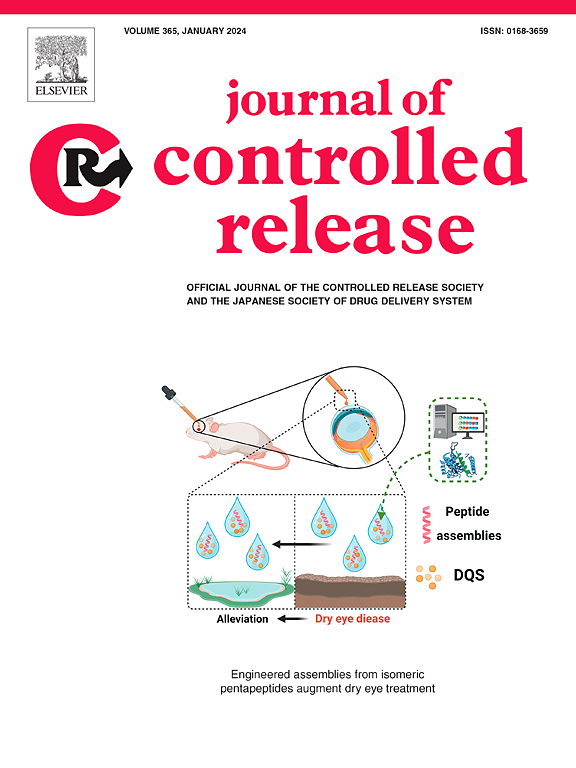离子液体形式依达拉奉经鼻至脑给药治疗脑缺血再灌注损伤的研究
IF 10.5
1区 医学
Q1 CHEMISTRY, MULTIDISCIPLINARY
引用次数: 0
摘要
经鼻给药经脑给药有望成为有效给药到中枢神经系统(CNS)的一种有前途的途径,因为它允许通过血脑屏障无创和直接给药到中枢神经系统。然而,由于粘膜上皮渗透性差和纤毛粘膜清除率低,给药的递送效率仍然有限。离子液体(ILs)的使用在生物医学工程中引起了极大的关注,因为它们具有改善活性药物成分的物理化学性质和克服阻碍药物递送到所需部位的生物屏障的潜力。我们假设il是一个很有希望的传递平台,可以通过鼻到脑的粘膜上皮实现有效的渗透。在此,我们开发了临床上常用的脑保护剂依达拉奉(edaravone- ils)的IL形式,并将其应用于鼻-脑输送治疗脑缺血/再灌注(I/R)损伤。通过一系列的体外研究,我们发现生物相容性依达拉奉- il与天然依达拉奉相比具有更强的抗氧化活性和更强的水溶性。经鼻给药后,依达拉奉- il给药到脑部的效率明显高于依达拉奉溶液。此外,经鼻给药依达拉奉- il可显著改善短暂性大脑中动脉闭塞大鼠的脑I/R损伤。这些研究结果表明,il为通过鼻-脑途径高效脑内药物递送提供了一条有希望的途径,依达拉奉- il可作为治疗脑I/R损伤的潜在脑保护剂。本文章由计算机程序翻译,如有差异,请以英文原文为准。

Intracerebral delivery of the ionic liquid form of edaravone via nose-to-brain delivery route for treating cerebral ischemia/reperfusion injury
Nose-to-brain drug delivery via intranasal administration is expected to be a promising route for efficient delivery to the central nervous system (CNS), as it allows for noninvasive and direct delivery of drugs to the CNS by avoiding the blood-brain barrier. However, the delivery efficiency of the administered drugs is still limited owing to poor mucosal epithelium permeation and mucociliary clearance. The use of ionic liquids (ILs) has garnered substantial attention in biomedical engineering for their potential to improve the physicochemical properties of active pharmaceutical ingredients and overcome biological barriers that impede drug delivery to the desired sites. We hypothesized that ILs are promising delivery platforms for achieving efficient permeation through the mucosal epithelium for nose-to-brain delivery. Herein, we newly developed IL forms of edaravone (edaravone-ILs), a clinically used cerebroprotectant, and applied them to nose-to-brain delivery to treat cerebral ischemia/reperfusion (I/R) injury. Through a series of in vitro studies, we found the biocompatible edaravone-IL which exhibits superior antioxidant activity and enhanced water solubility compared to that with native edaravone. Following intranasal administration, edaravone delivery to the brain was significantly more efficient with edaravone-IL than that with the edaravone solution. Moreover, the intranasal administration of edaravone-IL significantly ameliorated cerebral I/R injury in transient middle cerebral artery-occluded rats. These findings suggest that ILs offer a promising way for efficient intracerebral drug delivery via the nose-to-brain route and edaravone-IL could serve as a potential cerebroprotective agent for treating cerebral I/R injury.
求助全文
通过发布文献求助,成功后即可免费获取论文全文。
去求助
来源期刊

Journal of Controlled Release
医学-化学综合
CiteScore
18.50
自引率
5.60%
发文量
700
审稿时长
39 days
期刊介绍:
The Journal of Controlled Release (JCR) proudly serves as the Official Journal of the Controlled Release Society and the Japan Society of Drug Delivery System.
Dedicated to the broad field of delivery science and technology, JCR publishes high-quality research articles covering drug delivery systems and all facets of formulations. This includes the physicochemical and biological properties of drugs, design and characterization of dosage forms, release mechanisms, in vivo testing, and formulation research and development across pharmaceutical, diagnostic, agricultural, environmental, cosmetic, and food industries.
Priority is given to manuscripts that contribute to the fundamental understanding of principles or demonstrate the advantages of novel technologies in terms of safety and efficacy over current clinical standards. JCR strives to be a leading platform for advancements in delivery science and technology.
 求助内容:
求助内容: 应助结果提醒方式:
应助结果提醒方式:


